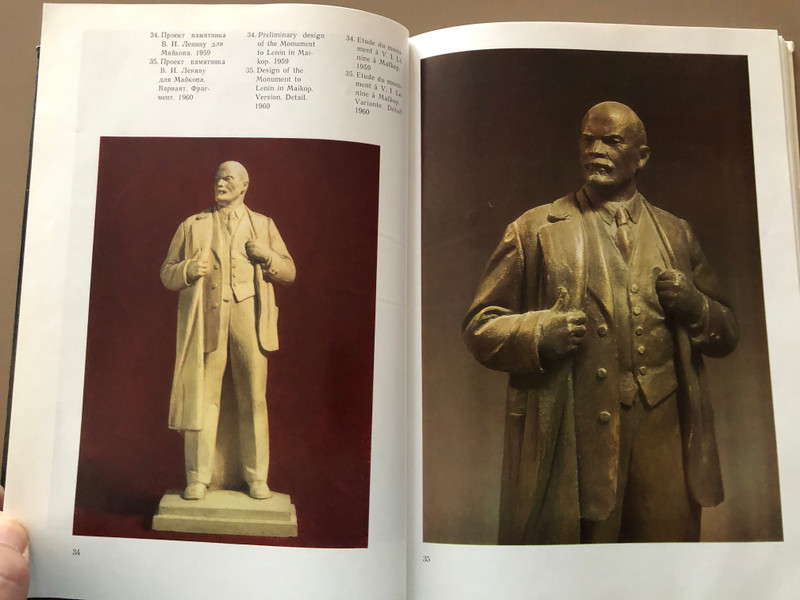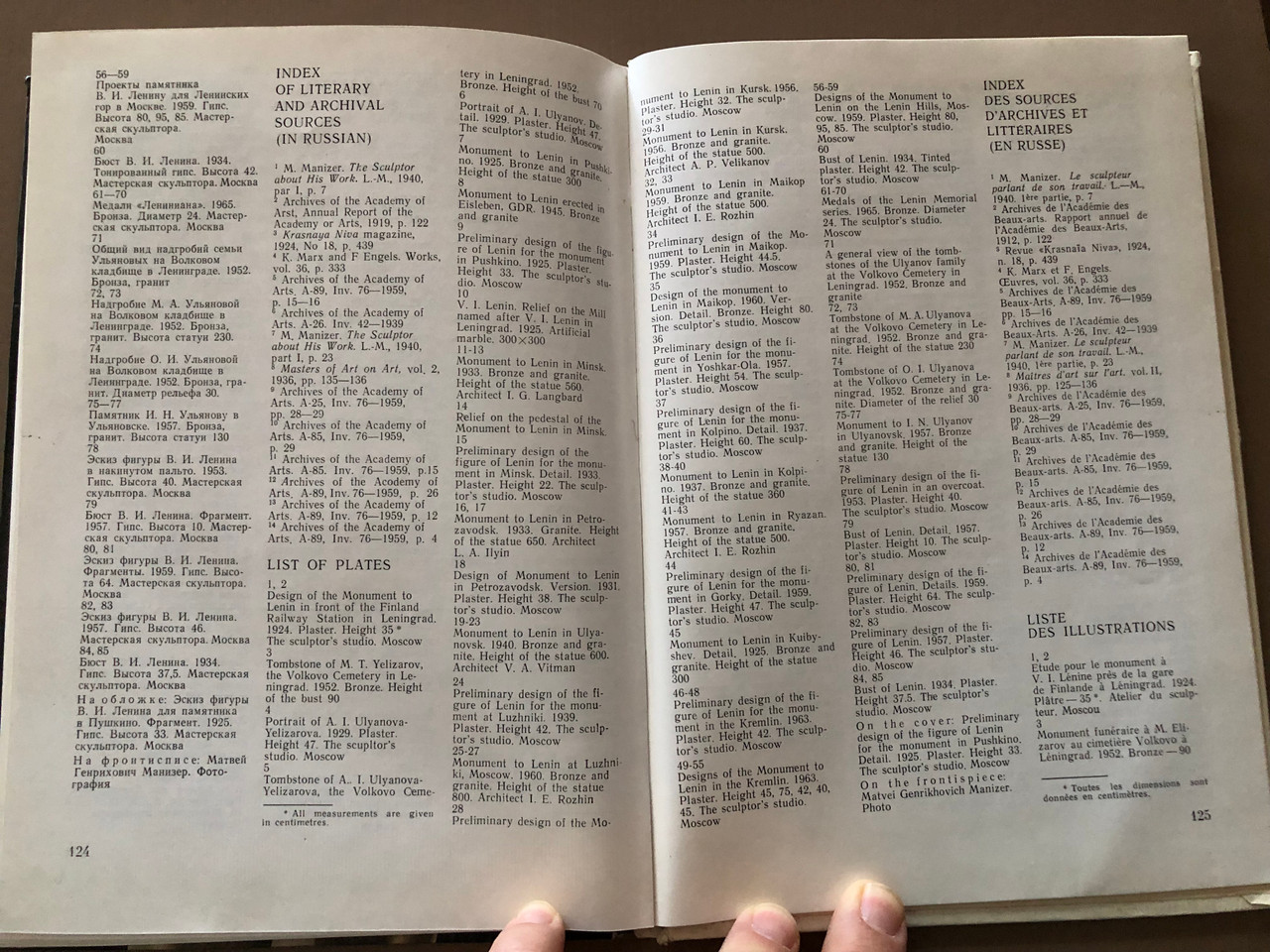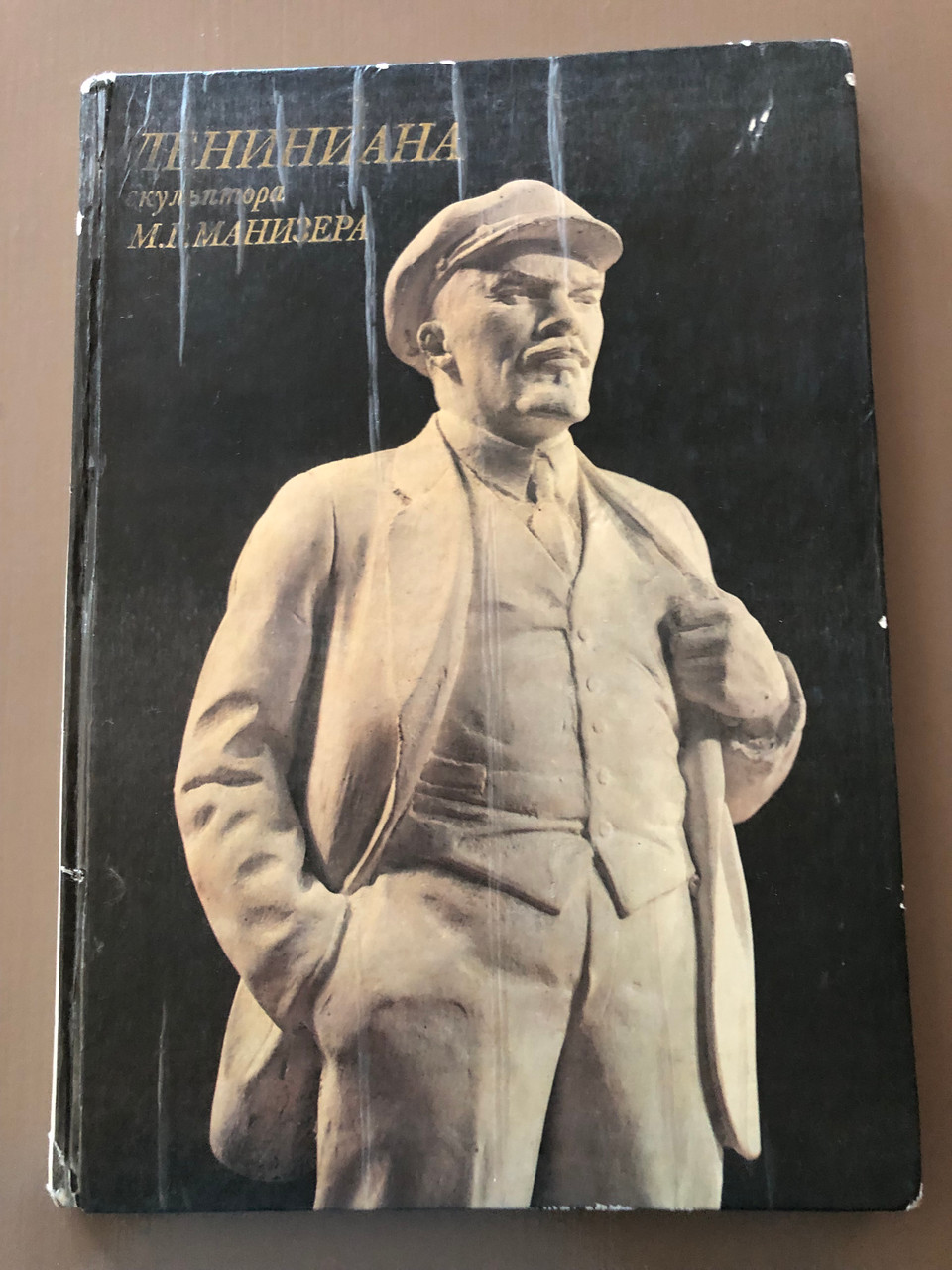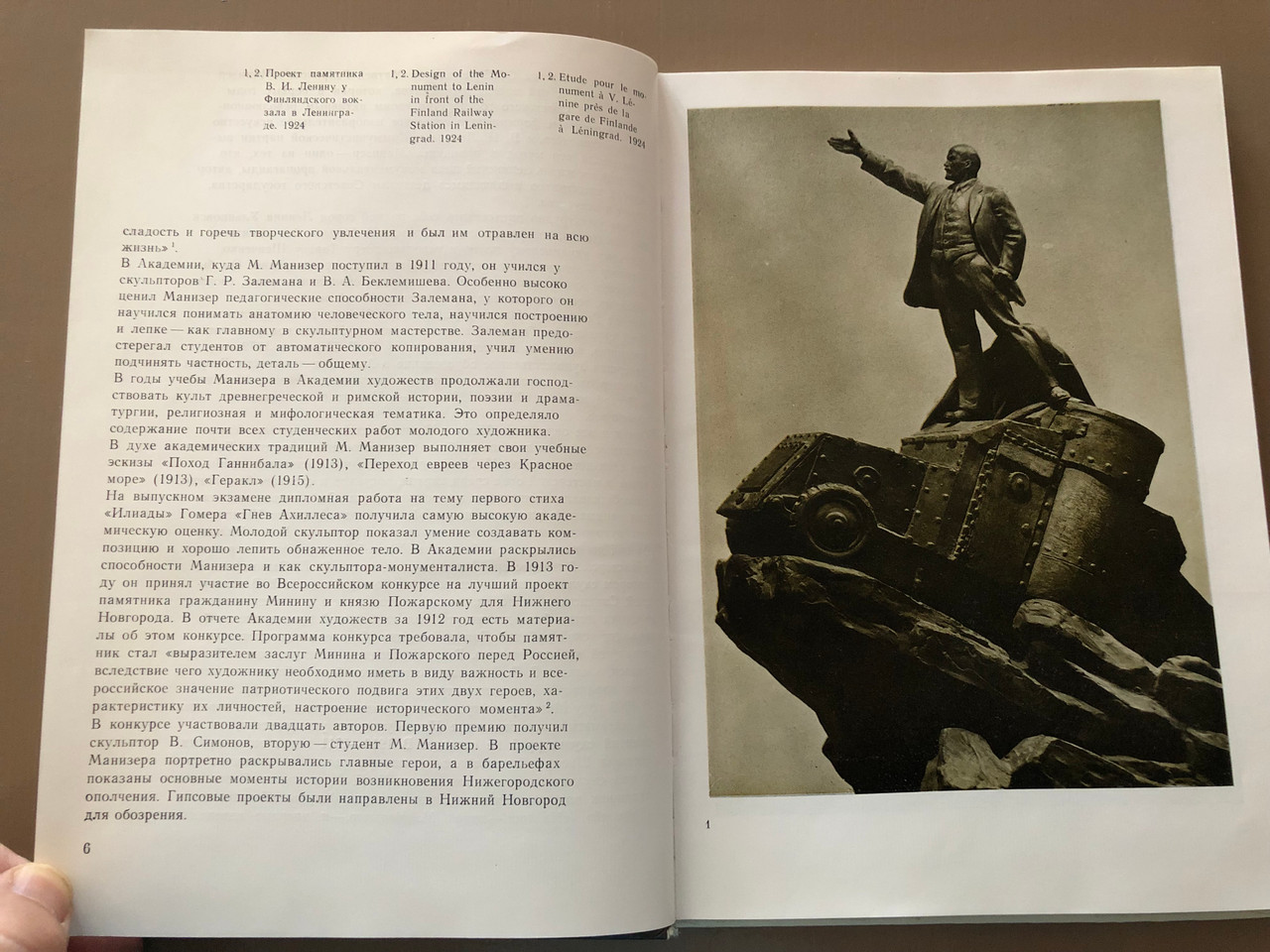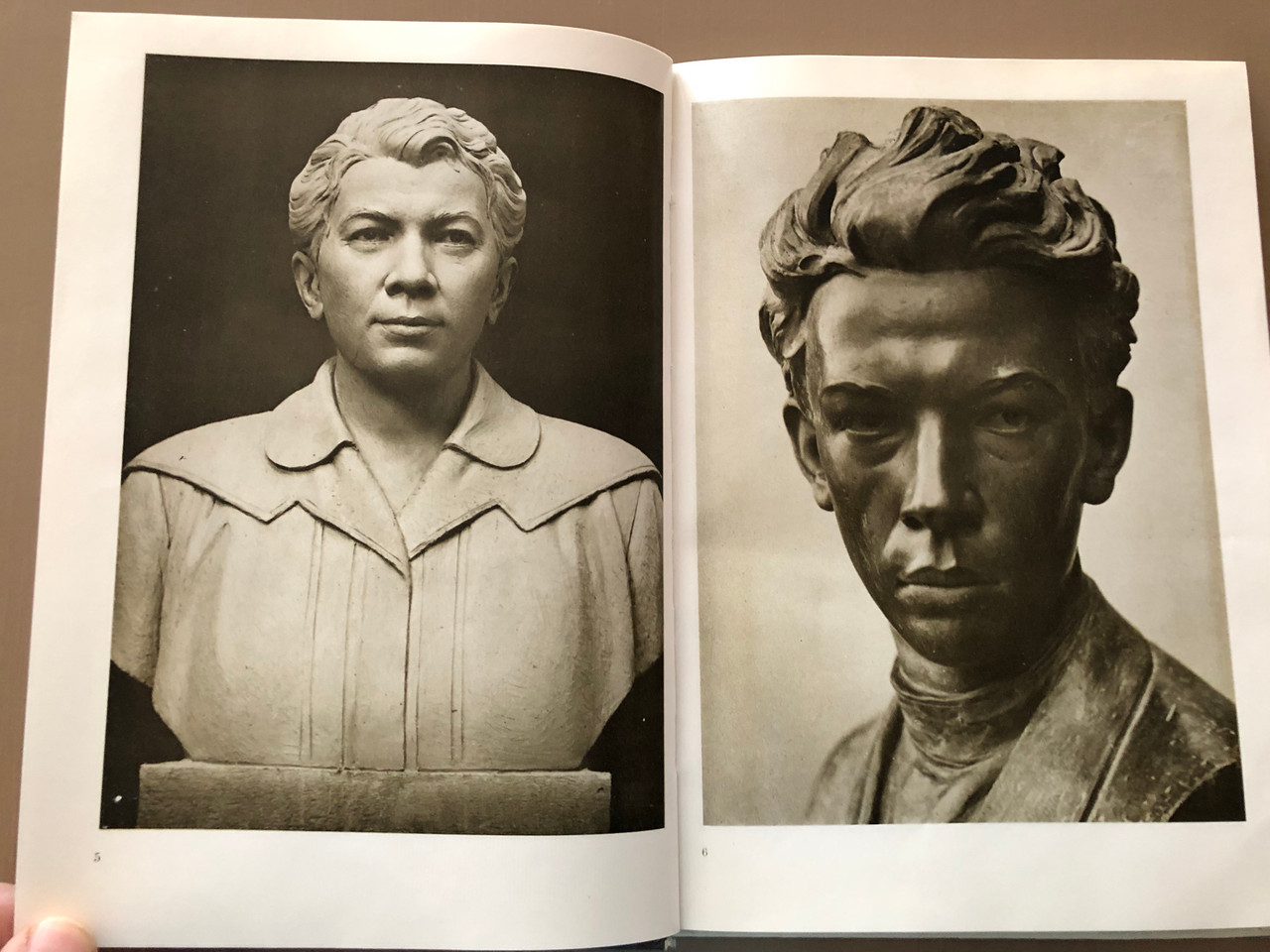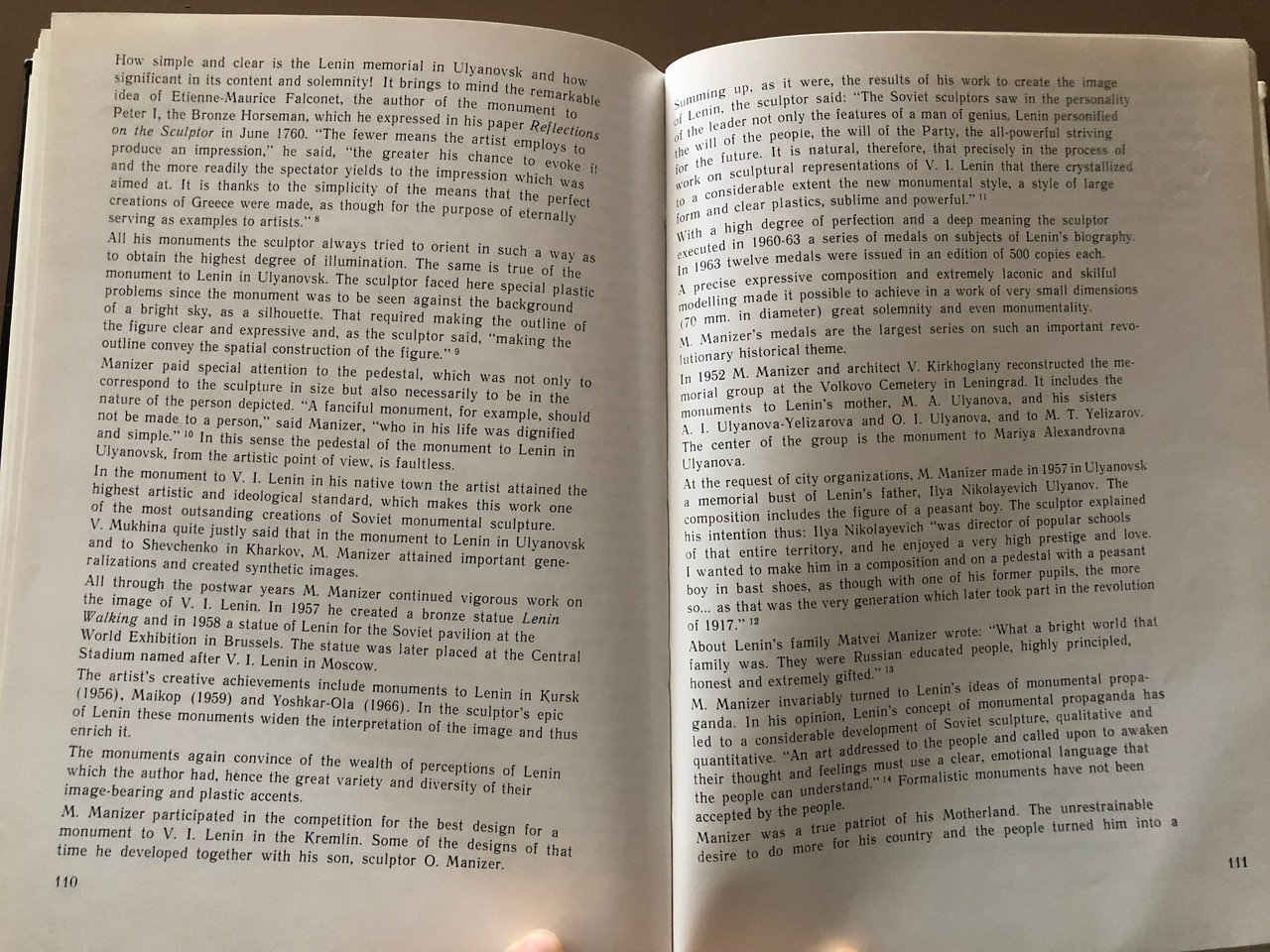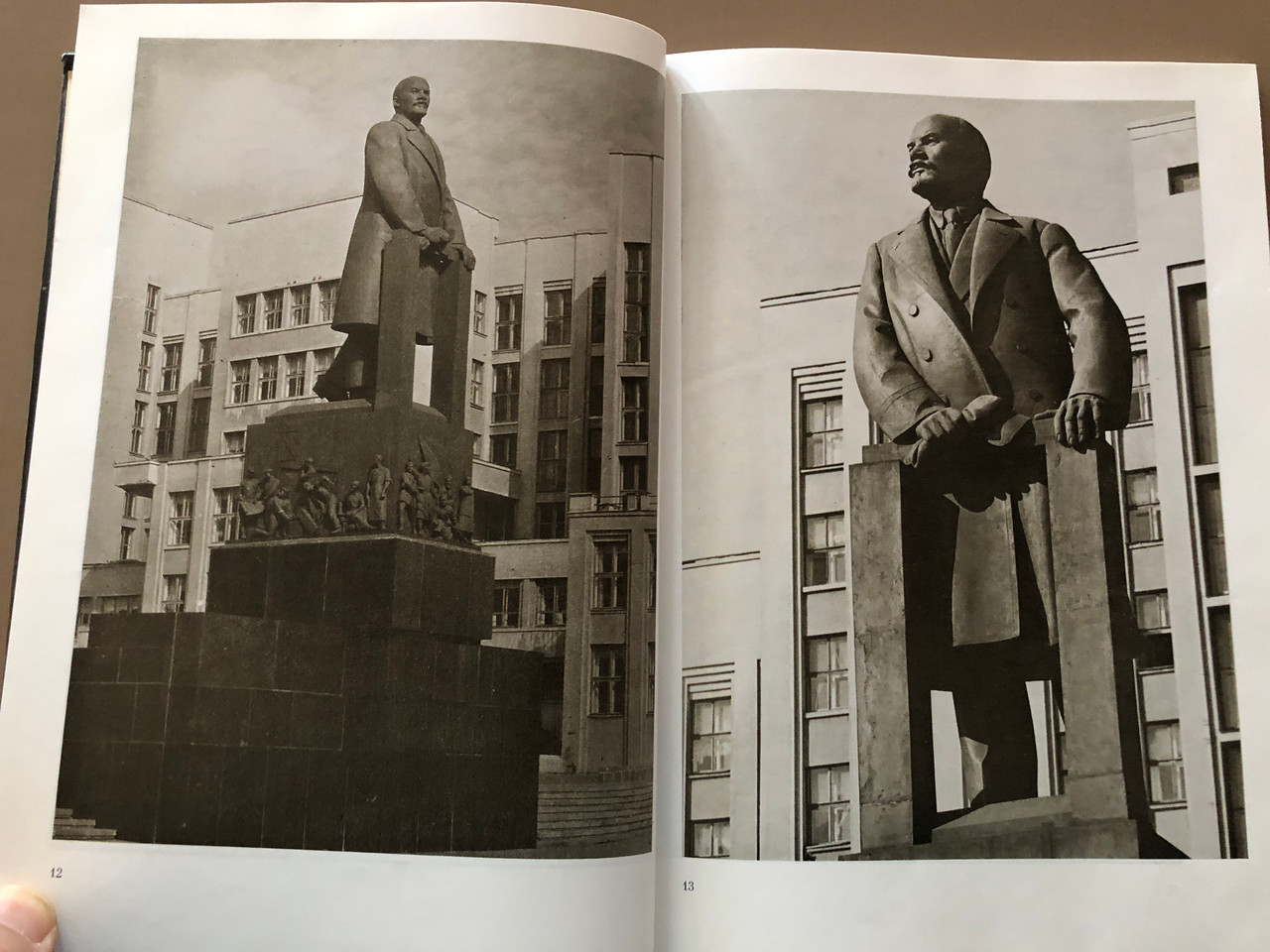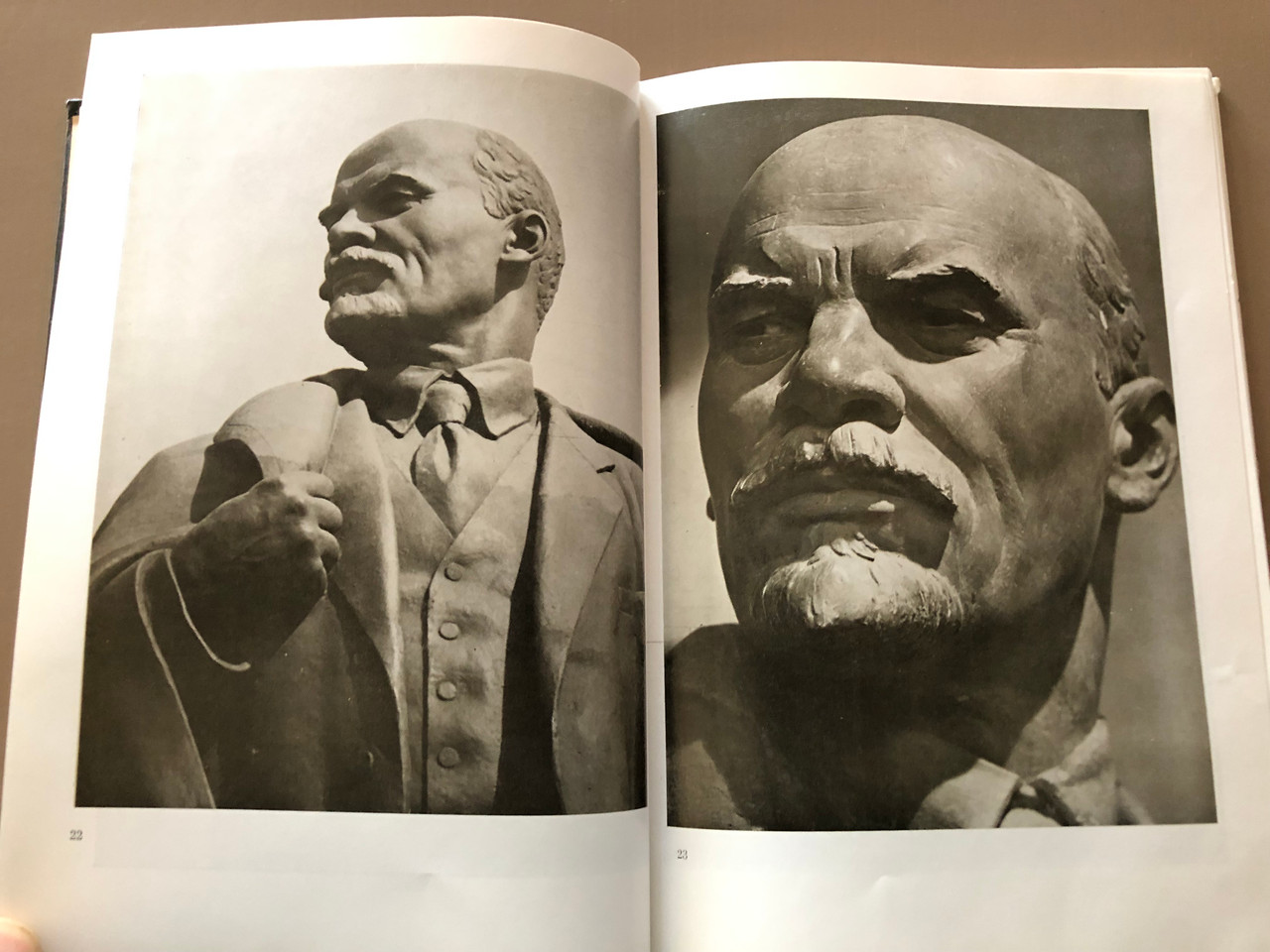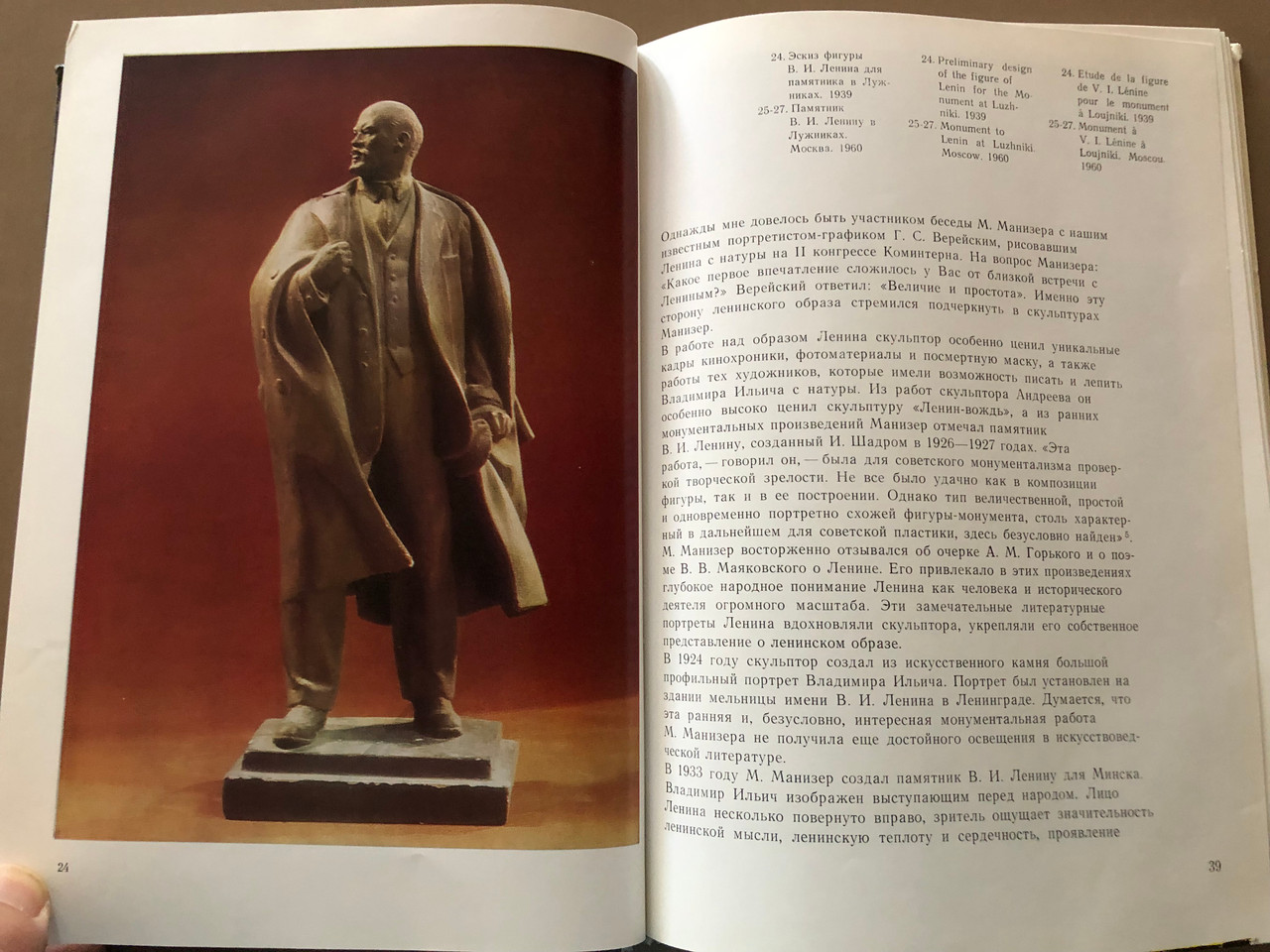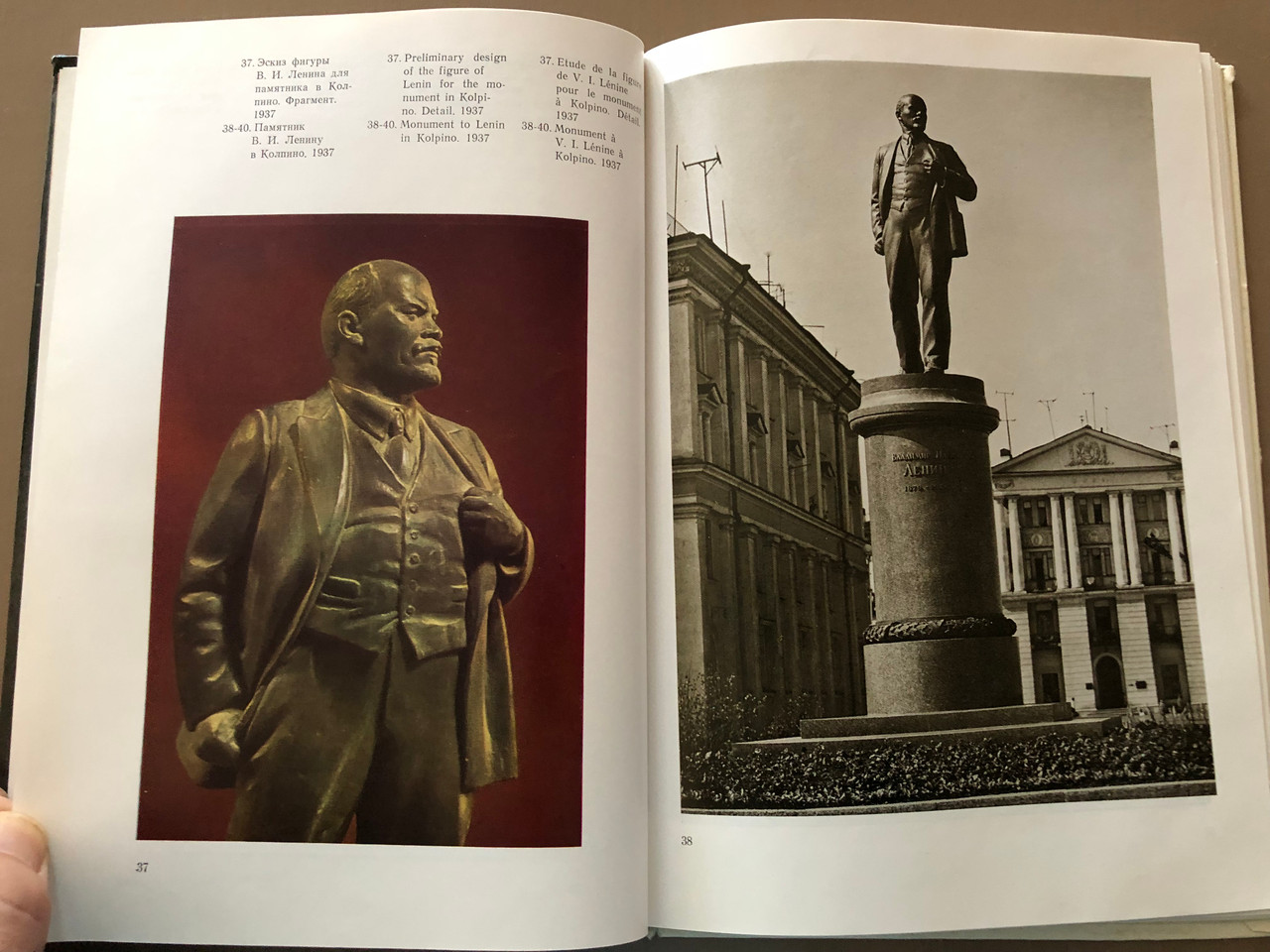Description
Lenin Sculpture: The Artistic Legacy of M.G. Manizer | Art Book (Trilingual Edition)
Лениниана скульптора М. Г. Манизера: Альбом
!!! Extremely rare book in used very good condition AS PICTURED !!!
Product Information
- Catalog Number: Not specified
- ISBN: Not specified
- Product Type: Art Book/Album (Trilingual)
- Languages: Russian with English and French translations
- Format: Hardcover
- Pages: 128 pages with 86 photos
- Publication Date: 1984
- Publisher: "Fine Arts" Publishing House (Изобразительное искусство), Moscow
- Print Run: 20,000 copies
- Price: 2 rubles 30 kopecks
Overview
"Lenin Sculpture: The Artistic Legacy of M.G. Manizer" is a comprehensive Trilingual art album showcasing the remarkable sculptural works of Matvey Genrikhovich Manizer (1891-1966), one of the Soviet Union's most distinguished sculptors. This collection focuses on Manizer's extensive "Leniniana" - works depicting Vladimir Lenin created over forty years of dedicated artistic practice. The album features not only well-known Lenin monuments installed throughout the Soviet Union but also includes sketches, busts, and medals created by the artist during different periods of his career. With 86 high-quality reproductions and insightful commentary in Russian, English, and French, this volume represents an important documentation of Soviet monumental art and the artistic interpretation of Lenin's image in sculpture.
Обзор
«Лениниана скульптора М.Г. Манизера» — это всесторонний художественный альбом, демонстрирующий выдающиеся скульптурные работы Матвея Генриховича Манизера (1891-1966), одного из самых известных скульпторов Советского Союза. Этот сборник посвящен обширной «Лениниане» Манизера — произведениям, изображающим Владимира Ленина, созданным за сорок лет преданной художественной практики. В альбоме представлены не только известные памятники Ленину, установленные по всему Советскому Союзу, но также эскизы, бюсты и медали, созданные художником в разные периоды его карьеры. С 86 высококачественными репродукциями и содержательными комментариями на русском, английском и французском языках, этот том представляет собой важный документ советского монументального искусства и художественной интерпретации образа Ленина в скульптуре.
Product Features
- Format: Hardcover art album with high-quality printing on 115g coated imported paper
- Dimensions: 70×100/16 format
- Content: 128 pages featuring 86 reproductions of sculptures, monuments, sketches, and medals
- Editorial Team: Compiled by O.M. Manizer and G.M. Manizer with introductory article by P.M. Sysoev
- Languages: Primary text in Russian with translations in English and French
- Printing: High-quality letterpress printing by Moscow Typography №5
- Visual Content: Black and white and color photographs of Manizer's works, including public monuments, studio pieces, and conceptual designs
Interesting Facts
The Artist and His Legacy
Matvey Genrikhovich Manizer (1891-1966) was a People's Artist of the USSR and a full member of the USSR Academy of Arts. Born into an artistic family—his father Heinrich was a student of the famous Russian painter Vasily Perov—Manizer was surrounded by art from an early age. He began studying drawing and sculpture at eight years old under the renowned sculptor M.A. Chizhov at the Stieglitz School.
Educational Background
Interestingly, despite his artistic inclinations, Manizer initially pursued astronomy and mathematics at St. Petersburg University in 1909. Even while studying sciences, he continued his artistic education by attending evening classes at the Society for the Encouragement of Arts under N.I. Andreoletti, where he created his first independent sculptures: "Stonemason" and "Galileo."
Lenin Plan for Monumental Propaganda
Manizer was one of the key artists who implemented Lenin's plan for monumental propaganda—a Soviet initiative to use art as a means of mass communication and education. His sculptures of Lenin and other revolutionary figures became iconic elements of the Soviet urban landscape, particularly his monuments in Lenin's birthplace of Ulyanovsk and his monument to Ukrainian poet-revolutionary Taras Shevchenko in Kharkiv.
Интересные факты
Художник и его наследие
Матвей Генрихович Манизер (1891-1966) был Народным художником СССР и действительным членом Академии художеств СССР. Родившись в художественной семье — его отец Генрих был учеником известного русского художника Василия Перова — Манизер с раннего возраста был окружен искусством. Он начал изучать рисунок и скульптуру в восьмилетнем возрасте под руководством известного скульптора М.А. Чижова в школе Штиглица.
Образование
Интересно, что несмотря на свои художественные наклонности, Манизер первоначально изучал астрономию и математику в Петербургском университете в 1909 году. Даже во время изучения наук, он продолжал свое художественное образование, посещая вечерние классы в Обществе поощрения художеств под руководством Н.И. Андреолетти, где создал свои первые самостоятельные скульптуры: «Каменщик» и «Галилей».
Ленинский план монументальной пропаганды
Манизер был одним из ключевых художников, реализовавших ленинский план монументальной пропаганды — советскую инициативу использования искусства как средства массовой коммуникации и образования. Его скульптуры Ленина и других революционных деятелей стали знаковыми элементами советского городского пейзажа, особенно его памятники в родном городе Ленина Ульяновске и памятник украинскому поэту-революционеру Тарасу Шевченко в Харькове.
Publishers
Published by "Fine Arts" Publishing House ("Изобразительное искусство"), Moscow in 1984. All rights reserved. The book was prepared for print on June 9, 1983, and signed for printing on July 5, 1984. Technical specifications indicate letterpress printing by Moscow Typography №5 of Soyuzpoligrafprom under the USSR State Committee for Publishing, Printing and Book Trade.
We value your feedback! Share your experience with this product to help others make informed decisions. Your review is important to us!
Hashtags
#ManizarSculpture #LeninMonuments #SovietArt #MonumentalPropaganda #SovietSculpture #ArtAlbum #LeninStatues #SovietHistory #RussianArt #MatveyManizer #BilingualArtBook
Хештеги
#СкульптураМанизера #ПамятникиЛенину #СоветскоеИскусство #МонументальнаяПропаганда #СоветскаяСкульптура #ХудожественныйАльбом #СтатуиЛенина #СоветскаяИстория #РусскоеИскусство #МатвейМанизер #ТрехъязычныйАльбом
ENGLISH TEXT IN THE BOOK:
Academician Matvei Genrikhovich Manizer. People's Artist of the Soviet Union, is one of the galaxy of artists who in the early years of existence of the Soviet state were by their active revolutionary creative efforts shaping Soviet imitative arts and, under the guidance of V. I. Lenin and the Communist Party, working out their method and principles. Manizer was one of those who worked to effectuate Lenin's plan of monumental propaganda, the author of many memorials to outstanding Soviet statesmen, scholars and artists.
Lenin's native town, Ulyanovsk, is actually inconceivable today without the monument created by the sculptor, as is Kharkov without the monument to the great Ukrainian poet and revolutionary Taras Shey-chenko.
Manizer was a single-minded man in his revolutionary convictions, he did not divide art to satisfy himself and to fulfil a social order. He was a Soviet artist with all his heart, his feelings and his thoughts, always principled, always with the Party.
Matvei Genrikhovich Manizer was born into the family of an artist in 1891. The sculptor's father, Genrikh Matveyevich, graduated from the Moscow School of Painting, where his instructor was V. G. Perov, in 1872. After completing his artistic education at the Academy of Arts, Genrikh Manizer was for about forty years an instructor in drawing at the Stieglitz School in St. Petersburg, and from 1906 to 1924 at the Civil Engineers' Institute.
The family and the entire environment of Matvei Manizer offered quite favourable conditions for his training and artistic development. Re-calling his childhood, M. Manizer said that his always being in his father's studio among paintings, drawings and pieces of sculpture undoubtebly contributed to his education as an artist. At the age of eight, the boy began to study drawing and modelling at the Stieglitz primary school under the guidance of Academician M. A. Chizhov, a well-known sculptor. During the year that preceded his entering the Academy. Matvei Manizer studied drawing in the studio of V. E. Sa vinsky, Professor of the Academy of Arts, whom the sculptor always recalled with much warmth. In the Savinsky studio, Manizer understood that simplicity, clarity and expressiveness of the drawing can be achieved only by a great deal of preliminary analytical work. Manizer's early drawings are expressly analytical.
His drawings of a later period, when Manizer was G. R. Zaleman's student, became more image-bearing and conveying the character and the condition of the model.
In 1909, Manizer entered the astronomy department of the St. Petersburg University, later changing it for the mathematics department. In 1910-11, he attended the evening School of the Society for the Promotion of Arts, where he took instruction in sculpture under the sculptured the figures of a Mason and Galileo. "Through them", wrote M. Manizer, "I first tasted the delight and bitterness of creative ardour, and was poisoned by it for life."
Manizer's instructors at the Academy were sculptors G. R. Zaleman and V. A. Beklemishev. Especially highly Manizer valued the teaching M. abilities of Zaleman, from whom he learnt to understand anatomy, learnt construction and molding as the most important elements in the art of sculpture. Zaleman warned his students against automatic copying. He taught to subordinate the particular, the detail to the general.
When Manizer studied at the Academy of Arts, the cult of ancient Greek and Roman history, poetry and drama, religious and mythological themes continued to reign supreme. That determined the content of almost all of the young artist's works as a student. In a spirit of academic traditions M. Manizer made his undergraduate works Hannibal's Campaign (1913), The Jews Crossing the Red Sea (1913), and Hercules (1915). The graduation diploma relief on the theme of the first verse of Homer's Iliad, The Wrath of Achilles received the highest academic appraisal. The young sculptor showed the ability to create a composition and well to mold a naked body. In the Academy Manizer also revealed a gift of a monumental sculptor. In 1913, he took part in an all-Russian competition for the best model of a monument to Citizen Minin and Prince Pozharsky to be erected in Nizhni Novgorod.
The Academy of Arts 1912 records contain an account of the competition. Its programme required that the monument should "express the services done by Minin and Pozharsky to Russia; consequently, the artist must have in mind the importance, and the significance for Russia as a whole, of the patriotic exploit of these two heroes, their characte-rization as personalities, and the spirit of the historical period."
Of the twenty competitors, the first prize was won by sculptor V. Simonov, and the second by student M. Manizer. Manizer's design gave portrait characteristics of the main heroes, with the bas-reliefs depicting the main events of the history of origin of the Nizhni Novgorod volunteer corps. Plaster models were sent to Nizhni Novgorod for display.
In 1915, M. Manizer received the first prize in the all-Russian competition for his design for a monument to K. D. Ushinsky. The success of the Academy student testified to a special nature of the young sculptor's talent and his great abilities in the field of monumental art. The monument to Ushinsky was not erected because of the hardships of the first world war.
In 1914 Manizer graduated from the physics and mathematics department of the St. Petersburg University and in 1916, the sculpture department of the Academy of Arts..
Matvei Manizer loved music and was an excellent cello player. In 1919, to complete his musical education, he entered the conservatoire as a senior student. For two years he played in professional orchestras in Pavlovsk, Kronstadt, Petrozavodsk, Pskov and other cities. He was happy to see the enthusiasm the performance of classical music aroused in common people, in the workers and soldiers.
A sculptor, mathematician and musician, Manizer saw his future, his true calling in sculpture, to which he devoted half a century of creative work.
The images of the new "heroic fighters, who have given all their life to the great cause of the revolution," ousted in the sculptor's art the themes of remote history. His work in portrait and monumental sculpture Manizer started in the early years of development of Soviet art. The artists then had before them a new and absorbing task that of showing the man born of the revolution, revealing his characteristic features, and seeing in a new light the role of outstanding personalities in history and the revolution. To discern and understand the new always means, for the artist himself, too, to view the world differently, to become part of that new.
For the young sculptor Lenin's decree on monumental propaganda "became the programme of all further activity, the purpose and meaning of the entire life." Lenin advanced the plan of monumental propaganda at the time when the Soviet country was waging a fierce struggle against the internal counter-revolution and world imperialism, when the country was in a state of devastation, when art was strongly influenced by formalism. The historical and aesthetic meaning of Lenin's plan of monumental propaganda was rightly seen by the sculptor as a specific measure taken by the state to make art serve the proletarian revolution, to integrate literature and art with the tasks of construction of the new socialist society, to create a lofty art of great agitational and educational importance. The history of the past knew no other party which could value so highly the role of art in the progress of society. Lenin's plan of monumental propaganda provided the artists with an ideological and artistic programme.
From the very start of the October Revolution, Soviet artists showed special interest in the personality of the leader of the revolution and the founder of the Soviet state, Vladimir Ilyich Lenin. His influence was tremendous, therefore to say the truth about such a man, to depict his extraordinary intellect, will, passion in the revolutionary struggle, conviction and fascination became a personal goal, the command of the heart and mind for many masters of literature and art.
The Second Congress of Soviets of the USSR, which opened in Moscow on January 26, 1924, adopted a resolution to perpetuate the memory of V. I. Lenin. A task of national importance was thus set before the artists.
What the monument to Lenin should be like was the subject widely discussed in the press in 1924. A noteworthy book of collected articles On Monuments to Lenin came out in the same year, its authors expressing various points of view. Of much interest is the article by L. Krasin On Monuments to Vladimir Ilyich, in which he formulated the requirements for the creation of the monument and the artist's special approach to the interpretation of the image of V. I. Lenin. In his opinion, to create a monument to Lenin requires a high degree of maturity of the artist. The personality of Lenin is so dear to every Soviet man and woman that the artist must create the image of Lenin as he was in reality, in the revolutionary struggle. The problem of likeness is one of the most important ones in the creation of such monument.
The book cited instances of wide discussion of this question at workers' meetings and in the press. It is significant that the very first monument to V. I. Lenin was made by a worker, an amateur artist, and erected by the workers of the Glukhovskaya textile mill.
The question was also discussed by progressive intellectuals in the capitalist countries. Of much interest is the opinion of an artist of the German proletariat, Käthe Kollwitz, about the monument to Lenin to be set up in Moscow. In her letter to the editor of the magazine Krasnaya Niva she wrote that the monument to Lenin must equally incorporate "supranational and Russian. It must have nothing routine, backneyed. I cannot imagine who of the sculptors I know could cope with this complicated task... An artist may, indeed, exist in Russia who will be able to give a proper plastic form to this phenomenal man.
But I do not know him. As I have already said, it must be something quite new, unconventional but at the same time without ornateness and unwarranted innovations. The monument must live." Käthe Kollwitz dreamed of a monument of a great realistic power, of an image that could be simple and great at the same time. Lenin is the leader of the world proletariat, therefore the monument to Lenin must reflect the international essence of Leninism.
In the 1924 debates on the nature of monument to V. I. Lenin, many vague and disputable views were expressed, some of the debaters excluding altogether the portrait likeness of the monument. M. Manizer, as his subsequent creative activities were to prove, correctly assessed all the trends in the discussion, accepting the valuable kernel it contained.
The history of Soviet imitative arts shows that important achievements were to be observed in the art of only those masters of sculpture who were faithful to the realistic method and treasured the great artistic traditions of the past ages. This is strikingly witnessed by the early monumental works of N. Andreyev, S. Konyonkov, M. Manizer, V. Si-naisky, S. Aleshin, S. Merkurov, L. Sherwood and some other sculptors. An important event in the Soviet sculptors' and architects' work to create the image of the leader was the competition for the best model of a monument to Lenin in the square in front of the Finland Railway Station in Leningrad. The competitors were to produce a truthful and realistic representation of Lenin. In 1924, an exhibition of designs was opened in the halls of the Academy of Arts in Leningrad. In Z. Goller-bakh's article in the book On Monuments to Lenin mention was made of two designs: by V. Shchuko and S. Yevseyev and by M. Manizer and I. Fomin. Regarding Manizer's design the article said: "It should be acknowledged that technically Manizer's works are distinguished by their completeness and expertise as compared with the sculptured works of other competitors."
The design for the monument in front of the Finland Railway Station was the sculptor's first attempt at a representation of Lenin. Manizer had collected a great deal of documentary material. He made sketches in the Mausoleum and studied materials connected with Lenin's arrival in Petrograd, and his first address to the revolutionary workers, soldiers and sailors of Petrograd in the square in front of the Finland Station. As was required, sculptors were to depict Lenin speaking from an armoured car.
The design accepted for erection was the one by Shchuko and Yevseyev. During the discussion of the monument to Lenin, Manizer shared the opinion of those who insisted that monuments to great historic personalities must always embody the popular idea for the hero.
The best solution of a monumental image, Manizer believed, was the one in which the artist was able to attain that many sidedness in the portrayal of a personality of which Engels said: "Each face is a type but at the same time also quite a definite individual." The sculptor strictly followed this principle in his work.
The sculptor saw Lenin in the spring of 1921 in Red Square in Moscow. His personal impression of the brief meeting a sort of cemented the comprehensive idea and impression which Manizer formed later from the wealth of material he received. It was important for the sculptor to have a clear perception of Lenin, to approach him in his imagination in order to visualize him quite vividly, as a living man! He sought the greatness and simplicity of the image, the determination and revolutionary romantic inspiration of Lenin, his natural inseverable connection with the Party and the people.
Very important for his creating the epic of Lenin was Manizer's meeting with Anna Ilyinichna Ulyanova-Yelizarova, Lenin's sister, who acquainted the sculptor with the family of Lenin, supplied him with many photographs and told him a great deal about the life of Vladimir Ilyich. During his first acquaintance with Anna Ilyinichna, Manizer made a memorial for the grave of her husband M. T. Yelizarov, first People's Commissar of Railways, at the Volkovo Cemetery, and a portrait of Lenin's elder brother, Alexander Ulyanov, executed by the tsarist government.
The sculptor had only one photograph to go by. Invaluable assistance to Manizer was given by Anna Ilvinichna who advised the sculptor at his work. During the same days Matvei Manizer made from life a portrait of Lenin's sister.
The first sketch of the design for a monument to V. I. Lenin in Ulyanovsk Manizer made back in 1924. Already that model accentuated Lenin's tremendous, unfailing will-power. The design attracted the attention of Anna Ilyinichna Ulyanova. She told the sculptor that Lenin was fond of windy weather, and it was therefore true to life to portray him in an overcoat thrown over his shoulders and blown by the wind, which would enhance the dynamism of the image. This motif of the original model the sculptor preserved and developed in the monument, imparting to it a great revolutionary romantic significance.
In each of his new solutions of a monument to V. I. Lenin, Manizer always found both a new theme and a new feature for the development of the image. But the artist considered it necessary to combine in each work Lenin's high humanity with solemnity and romanticism. Artists and art critics note that in his epic of Lenin M. Manizer strived to create Lenin's generalizing image, to demonstrate in the memorials the social and historic role of the leader of the proletarian revolution and the organizer of the world's first socialist state.
The sculptor devoted over forty years to persevering and inspired efforts to create the image of the great leader. Of much interest is the sculptor's method of work. The preparatory stage included the study of V. I. Lenin's works, documentary material portraying Lenin and impressions of Lenin's contemporaries and comrades, and acquaintance with the documents having to do with the life and activities of Lenin.
What Lenin's relatives told about him contributed a great deal to the sculptor's conception of the leader. His talks with Nadezhda Konstantinovna Krupskaya and with Lenin's sisters Anna Ilyinichna and Mariya Ilyinichna helped the artist to recreate the image of Lenin at all stages of his life.
Besides, Manizer, carefully studied the experience of painters and sculptors who had been able to communicate with Vladimir Ilyich and to make portraits and sketches of him. I once happened to take part in a talk M. Manizer had with our well-known portraitist G. S. Vereisky, who made drawings of Lenin at the Second Congress of the Comintern.
To Manizer's question: "What was your first impression of your meeting with Lenin at a short distance?" Vereisky replied: "Greatness and simplicity." It was this aspect of Lenin's personality that Manizer tried to accentuate. The sculptor very much valued unique documentary films, photographs and the death-mask, as well as the works of the artists who had the opportunity of painting and molding Vladimir Ilyich from life. Of sculptor Andreyev's works he especially appreciated the sculpture Lenin the Leader, and of the early memorials Manizer preferred the monument to V. I. Lenin made by I. Shadr in 1926-27. "This work," he said, "was for Soviet monumental art the touchstone of creative maturity.
Not everything was well done both as regards the composition of the figure and its construction. But the type of the sublime, simple and at the same time lifelike figure of the monument, subsequently so characteristic of Soviet plastic art, was no doubt found here."
M. Manizer spoke enthusiastically about the essay of Maxim Gorky and the poem of Mayakovsky about Lenin. He admired in these works the profoundly popular understanding of Lenin as a man and historical personality of enormous calibre. These remarkable literary portraits of Lenin inspired the sculptor and confirmed his own vision of the great leader.
In 1924 the sculptor made of artificial stone a large profile of Vladimir Ilyich. The portrait was fixed to the building of the mill named after V. I. Lenin in Leningrad. This early and, no doubt, interesting work of M. Manizer does not seem to have been properly appreciated by art critics.
In 1933 M. Manizer created a monument to V. I. Lenin for Minsk.
Lenin is portrayed addressing the people. His face is somewhat turned to the right, the onlooker feels the importance of Lenin's thought and Lenin's warmth and cordiality, whose manifestation was so characteristic of the leader when he was meeting the people, indeed, any person with whom he associated or worked. Plastically the whole figure is executed clearly and very rhythmically. Forming an integral part of the square in the Byelorussian capital, the monument has imparted to it special solemnity.
The pedestal contains reliefs on the subjects: the October Revolution. the Civil War, industrialization and collectivization.
The monument was unveiled on November 7, 1933.
During the war the nazis carried away the statue of Lenin. The monument was recast after the existing plaster model.
In 1931 the sculptor started jointly with architect L. A. Ilyin making a model of a monument to V. I. Lenin to be erected in Petrozavodsk. As was desired by the city organizations, the monument was made of grey Karelian granite. Manizer wrote in this connection: "As for me, I was much interested in the clients' desire that the whole monument, including the figure, should be carved from the local granite." The Petrozavodsk scultpure was the only one Manizer made of granite. The work on the monument seemed to have convinced the artist himself that his gift required more flexible materials such as bronze and marble. Indeed with these materials he was in his element.
V. I. Lenin is portrayed speaking. The whole figure is executed in an impulsive energetic manner. As energetic and even somewhat sharp are the features of the face. The sculpture is so constructed as to take into account the northern weather with its frequent fogs and diffused daylight. For the grey Karelian granite not to look too monotonous, the author specially sharpened the form of the sculpture.
"Granite is a material requiring compact forms," said M. Manizer, "and in the conditions of the north it is not an advantageous material, for granite lives when it is sunlit..."
A certain simplification and sketchiness of form in the Petrozavodsk monument was necessitated by the material in the first place. The sculptor, however, theoretically, too, admitted that in certain circumstances simplification of form is needed when creating a monumental sculpture.
A monumental trend in Soviet sculpture was characteristic of the 1920s and the 1930s. In those years even in smaller forms of sculpture there appeared a number of works monumental in their nature: Cobblestone the Weapon of the Proletariat by I. Shadr, The Death of the Leader by S. Merkurov, Lenin the Leader by N. Andreyev, and others. All that testified to a great upsurge of Soviet plastic art. Under the influence of the revolutionary ideas of October 1917 and of Lenin's policy in art, the great revolutionary and artistic principles of the Soviet realistic art made astounding progress in those years.
The summit of the artist's work was the monument to V. I. Lenin in Ulyanovsk. The assignment to erect a monument to Lenin in his native town deeply stirred the sculptor; his experience of many years seemed not enough to him. He was well aware of the great responsibility he assumed by making a monument in the town where Lenin was born. In the Ulyanovsk monument Manizer attained many sided characterization of the image. Lenin not merely addresses the people, not merely appeals to the people, he also rouses the masses and leads them. One feels the powerful energy and all-conquering dynamism of his personality. Forward, always forward, is the message of Lenin's image. The pathos of revolutionary struggle and ardent dedication to the future makes the statue one of the most romantic works in Soviet monumental art.
"Revolutionary romanticism the inalienable part of the method of socialist realism is inevitably present in the solution of any monument of our time," wrote M. Manizer. The sculptor has created the image of Vladimir Ilyich full of profound philosophical generalization.
The monument in Ulyanovsk is not very large. Manizer has achieved a highly monumental impression by its energetic form, which has become a powerful method of reproducing Lenin's heroic image. How simple and clear is the Lenin memorial in Ulyanovsk and how significant in its content and solemnity! It brings to mind the remarkable idea of Etienne-Maurice Falconet, the author of the monument to Peter I, the Bronze Horseman, which he expressed in his paper Reflections on the Sculptor in June 1760. "The fewer means the artist employs to produce an impression," he said, "the greater his chance to evoke it and the more readily the spectator yields to the impression which was aimed at. It is thanks to the simplicity of the means that the perfect creations of Greece were made, as though for the purpose of eternally serving as examples to artists."
All his monuments the sculptor always tried to orient in such a way as to obtain the highest degree of illumination. The same is true of the monument to Lenin in Ulyanovsk. The sculptor faced here special plastic problems since the monument was to be seen against the background of a bright sky, as a silhouette. That required making the outline of the figure clear and expressive and, as the sculptor said, "making the outline convey the spatial construction of the figure."
Manizer paid special attention to the pedestal, which was not only to correspond to the sculpture in size but also necessarily to be in the nature of the person depicted. "A fanciful monument, for example, should not be made to a person," said Manizer, "who in his life was dignified and simple." In this sense the pedestal of the monument to Lenin in Ulyanovsk, from the artistic point of view, is faultless.
In the monument to V. I. Lenin in his native town the artist attained the highest artistic and ideological standard, which makes this work one of the most outsanding creations of Soviet monumental sculpture.
V. Mukhina quite justly said that in the monument to Lenin in Ulyanovsk and to Shevchenko in Kharkov, M. Manizer attained important generalizations and created synthetic images.
All through the postwar years M. Manizer continued vigorous work on the image of V. I. Lenin. In 1957 he created a bronze statue Lenin Walking and in 1958 a statue of Lenin for the Soviet pavilion at the World Exhibition in Brussels. The statue was later placed at the Central Stadium named after V. I. Lenin in Moscow.
The artist's creative achievements include monuments to Lenin in Kursk (1956), Maikop (1959) and Yoshkar-Ola (1966). In the sculptor's epic of Lenin these monuments widen the interpretation of the image and thus enrich it.
The monuments again convince of the wealth of perceptions of Lenin which the author had, hence the great variety and diversity of their image-bearing and plastic accents.
M. Manizer participated in the competition for the best design for a monument to V. I. Lenin in the Kremlin. Some of the designs of that time he developed together with his son, sculptor O. Manizer.
Summing up, as it were, the results of his work to create the image of Lenin, the sculptor said: "The Soviet sculptors saw in the personality of the leader not only the features of a man of genius. Lenin personified the will of the people, the will of the Party, the all-powerful striving for the future. It is natural, therefore, that precisely in the process of work on sculptural representations of V. I. Lenin that there crystallized to a considerable extent the new monumental style, a style of large form and clear plastics, sublime and powerful."
With a high degree of perfection and a deep meaning the sculptor executed in 1960-63 a series of medals on subjects of Lenin's biography. In 1963 twelve medals were issued in an edition of 500 copies each. A precise expressive composition and extremely laconic and skilful modelling made it possible to achieve in a work of very small dimensions (70 mm. in diameter) great solemnity and even monumentality. M. Manizer's medals are the largest series on such an important revolutionary historical theme.
In 1952 M. Manizer and architect V. Kirkhoglany reconstructed the memorial group at the Volkovo Cemetery in Leningrad. It includes the monuments to Lenin's mother, M. A. Ulyanova, and his sisters A. I. Ulyanova-Yelizarova and O. I. Ulyanova, and to M. T. Yelizarov. The center of the group is the monument to Mariya Alexandrovna Ulyanova.
At the request of city organizations, M. Manizer made in 1957 in Ulyanovsk a memorial bust of Lenin's father, Ilya Nikolayevich Ulyanov. The composition includes the figure of a peasant boy. The sculptor explained his intention thus: Ilya Nikolayevich "was director of popular schools of that entire territory, and he enjoyed a very high prestige and love. I wanted to make him in a composition and on a pedestal with a peasant boy in bast shoes, as though with one of his former pupils, the more so... as that was the very generation which later took part in the revolution of 1917."
About Lenin's family Matvei Manizer wrote: "What a bright world that family was. They were Russian educated people, highly principled, honest and extremely gifted."
M. Manizer invariably turned to Lenin's ideas of monumental propaganda. In his opinion, Lenin's concept of monumental propaganda has led to a considerable development of Soviet sculpture, qualitative and quantitative. "An art addressed to the people and called upon to awaken their thought and feelings must use a clear, emotional language that the people can understand." Formalistic monuments have not been accepted by the people.
Manizer was a true patriot of his Motherland. The unrestrainable desire to do more for his country and the people turned him into a toiler of powerful energy, utmost discipline and purposefulness. The sculptor used to say that a Soviet person born with a talent must work with an energy of tens and hundreds of ordinary working people. An artist must give everything to the people, and the people must take everything from the artist. He regarded other relations between a talent and the people as blasphemy, as anarchical parasitism. Manizer has earned love and respect he well deserves. He has done everything he could do, everything that was within the power of his talent, human energy and the span of his life.
Лениниана скульптора М. Г. Манизера: Альбом /М 23Авт.-сост.: О. М. Манизер, Г. М. Манизер. Авт. вступ. статьи П. М. Сысоев. - М.: Изобраз. искусство, 1984. -128 с. ил.
В пер.: 2 р. 30 к. 20 000.
Народный художник СССР, действительный член Академии художеств СССР Матвей Генрихович Манизер (1891-1966), автор памятников выдаю щимся деятелям Советского государства, один из активных участников ле нинского плана монументальной пропаганды. Свыше сорока лет напряжен ного и вдохновенного труда скульптор отдал созданию образа вождя про-летарской революции В. И. Ленина. Помимо известных памятников Ленину, находящихся во многих городах Советского Союза, в альбоме представлены выполненные в разные годы эскизы памятников, бюсты, медали. Вступитель-ная статья рассказывает о творческом пути художника. В альбоме 86 репродукций.
Для любителей изобразительного искусства.
M 4903030000-117 024(01)-84
25-84
ББК 133(2)7 7302
pages 56-59 Designs of the Monument to Lenin on the Lenin Hills, Moscow. 1959. Plaster. Height 80, 95, 85. The sculptor's studio. Moscow
60 Bust of Lenin. 1934, Tinted plaster. Height 42. The sculp-tor's studio. Moscow
61-70 Medals of the Lenin Memorial series. 1965. Bronze. Diameter 24. The sculptor's studio. Moscow
71 A general view of the tomb-stones of the Ulyanov family at the Volkovo Cemetery in Leningrad. 1952, Bronze and granite
72, 73 Tombstone of M. A. Ulyanova at the Volkovo Cemetery in Le-ningrad, 1952. Bronze and gra-nite. Height of the statue 230
74 Tombstone of O. I. Ulyanova at the Volkovo Cemetery in Le-ningrad, 1952. Bronze and gra-nite. Diameter of the relief 30
75-77 Monument to I. N. Ulyanov in Ulyanovsk, 1957. Bronze and granite. Height of the statue 130
78 Preliminary design of the fi-gure of Lenin in an overcoat. 1953. Plaster. Height 40. The sculptor's studio. Moscow
79 Bust of Lenin. Detail, 1957. Plaster. Height 10. The sculp-tor's studio. Moscow
80, 81 Preliminary design of the figure of Lenin, Details, 1959. Plaster. Height 64. The sculp-tor's studio. Moscow
82, 83 Preliminary design of the figure of Lenin, 1957. Plaster. Height 46. The sculptor's stu-dio. Moscow
84, 85 Bust of Lenin. 1934, Plaster. Height 37.5. The sculptor's studio, Moscow
On the cover: Preliminary design of the figure of Lenin for the monument in Pushkino, Detail. 1925. Plaster. Height 33. The sculptor's studio, Moscow


































